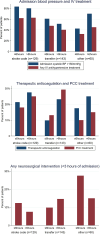Time for "Code ICH"? Workflow Metrics of Hyperacute Treatments and Outcome in Patients with Intracerebral Haemorrhage
- PMID: 38198772
- PMCID: PMC11633875
- DOI: 10.1159/000536099
Time for "Code ICH"? Workflow Metrics of Hyperacute Treatments and Outcome in Patients with Intracerebral Haemorrhage
Abstract
Introduction: Knowledge about uptake and workflow metrics of hyperacute treatments in patients with non-traumatic intracerebral haemorrhage (ICH) in the emergency department is scarce.
Methods: Single-centre retrospective study of consecutive patients with ICH between 01/2018-08/2020. We assessed uptake and workflow metrics of acute therapies overall and according to referral mode (stroke code, transfer from other hospital, or other).
Results: We enrolled 332 patients (age 73 years, IQR: 63-81 and GCS 14 points, IQR: 11-15, onset-to-admission time 284 min, IQR: 111-708 min), of whom 101 patients (35%) had lobar haematoma. Mode of referral was stroke code in 129 patients (38%), transfer from other hospital in 143 patients (43%), and arrival by other means in 60 patients (18%). Overall, 143 of 216 (66%) patients with systolic blood pressure >150 mm Hg received IV-antihypertensive treatment, and 67 of 76 (88%) on therapeutic oral anticoagulation received prothrombin complex concentrate treatment (PCC). Forty-six patients (14%) received any neurosurgical intervention within 3 h of admission. Median treatment times from admission to first IV-antihypertensive treatment were 38 min (IQR: 18-72 min) and 59 min (IQR: 37-111 min) for PCC, with significant differences according to mode of referral (p < 0.001) but not early arrival (≤6 h of onset, p = 0.92). The median time in the emergency department was 139 min (IQR: 85-220 min), and among patients with elevated blood pressure, only 44% achieved a successful control (<140 mm Hg) during ED stay. In multivariate analysis, code ICH concordant treatment was associated with significantly lower odds for in-hospital mortality (aOR 0.30, 95% CI: 0.12-0.73, p = 0.008) and non-significant trends towards better functional outcome measured using the modified Rankin scale score at 3 months (aOR for ordinal shift 0.54, 95% CI: 0.26-1.12, p = 0.097).
Conclusion: Uptake of hyperacute therapies for ICH treatment in the ED is heterogeneous. Treatment delays are short, but not all patients achieve treatment targets during ED stay. Code ICH-concordant treatment may improve clinical outcomes. Further improvements seem achievable by advocating for a "code ICH" to streamline acute treatments.
Keywords: Anticoagulation; Blood pressure; Intracerebral haemorrhage; Reversal; Treatment.
© 2024 The Author(s). Published by S. Karger AG, Basel.
Conflict of interest statement
The authors have no conflicts of interest to declare.
Figures




References
-
- Van Asch CJ, Luitse MJ, Rinkel GJ, van der Tweel I, Algra A, Klijn CJ. Incidence, case fatality, and functional outcome of intracerebral haemorrhage over time, according to age, sex, and ethnic origin: a systematic review and meta-analysis. Lancet Neurol. 2010;9(2):167–76. - PubMed
-
- Bejot Y, Cordonnier C, Durier J, Aboa-Eboule C, Rouaud O, Giroud M. Intracerebral haemorrhage profiles are changing: results from the Dijon population-based study. Brain. 2013;136(Pt 2):658–64. - PubMed
-
- Poon MT, Fonville AF, Al-Shahi Salman R. Long-term prognosis after intracerebral haemorrhage: systematic review and meta-analysis. J Neurol Neurosurg Psychiatry. 2014;85(6):660–7. - PubMed

